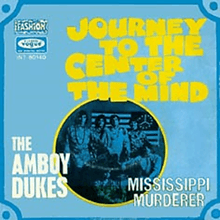Journey to the Center of the Mind (song)
| "Journey to the Center of the Mind" | ||||
|---|---|---|---|---|
 | ||||
| Single by The Amboy Dukes | ||||
| from the album Journey to the Center of the Mind | ||||
| B-side | "Mississippi Murderer" | |||
| Released | May 1968 | |||
| Format | 7-inch single | |||
| Recorded | 1967 | |||
| Genre | ||||
| Length | 3:11 | |||
| Label | Mainstream | |||
| Writer(s) | ||||
| Producer(s) | Bob Shad | |||
| The Amboy Dukes singles chronology | ||||
| ||||
"Journey to the Center of the Mind" is a song released by The Amboy Dukes in 1968. It reached number 16 on the Billboard charts in 1968.[1]
Original recording
Unlike their previous recordings, "Journey to the Center of the Mind" had a more psychedelic garage rock sound, influenced by the Yardbirds.[2][3] The song features lyrics written by the Dukes' second guitarist Steve Farmer,[4] and the melody written by Ted Nugent.[5][6] The song was recorded with a higher budget than their past recordings. During the recording of the song there was a lot of tension between the band members, and a few of the members quit after the album was released. Released in the summer of 1968, the single helped define the psychedelic era as it peaked at # 16 on the Billboard charts.[7][8]
Other versions
The song "Journey to the Center of the Mind" was covered by Slade (as "Ambrose Slade") in 1969 on the album Beginnings, by The Ramones in 1994 on Acid Eaters[9] and by Sun City Girls in 2001 on Libyan Dream. Journey to the Center of the Mind was included in the influential compilation album Nuggets: Original Artyfacts from the First Psychedelic Era, 1965–1968, on the 1998 CD reissue, as a bonus track.
Nugent re-made the song on his 2007 album Love Grenade.
The lyrics of the song are generally thought to have references to drug use.[10][11][12][13]
References
- ↑ A collective effort of many writers (29 April 2014). The World's Largest Collection of What You've Never Read, Thought, Heard, Imagined, Considered or Dreamed: How to Think in Your Right Brain OR Yes! Something for Everyone. AuthorHouse. pp. 36–. ISBN 978-1-4969-0462-1.
- ↑ Maury Dean (2003). Rock and Roll. Algora Publishing. p. 337. ISBN 978-0-87586-207-1.
- ↑ Mike McPadden (1 May 2012). If You Like Metallica...: Here Are Over 200 Bands, CDs, Movies, and Other Oddities That You Will Love. Backbeat Books. p. 31. ISBN 978-1-4768-1357-8.
- ↑ David A. Carson (2006). Grit, Noise, and Revolution: The Birth of Detroit Rock 'n' Roll. University of Michigan Press. pp. 144–. ISBN 0-472-03190-2.
- ↑ Maury Dean (2003). Rock and Roll. Algora Publishing. pp. 662–. ISBN 978-0-87586-207-1.
- ↑ Department of Music Theory The University of Michigan Walter Everett Associate Professor of Music and Chair (7 November 2008). The Foundations of Rock : From "Blue Suede Shoes" to "Suite: Judy Blue Eyes": From "Blue Suede Shoes" to "Suite: Judy Blue Eyes". Oxford University Press. pp. 274–. ISBN 978-0-19-971870-2.
- ↑ MRRL Hall of Fame, "Amboy Dukes"
- ↑ Ken Goffman; Dan Joy (18 December 2007). Counterculture Through the Ages: From Abraham to Acid House. Random House Publishing Group. pp. 1271–. ISBN 978-0-307-41483-0.
- ↑ Everett True (17 May 2010). Hey Ho Let's Go: The Story Of The Ramones: The Story of The Ramones. Omnibus Press. pp. 468–. ISBN 978-0-85712-060-1.
- ↑ James Franklin Harris (January 1993). Philosophy at 33 1/3 Rpm: Themes of Classic Rock Music. Open Court Publishing. pp. 133–. ISBN 978-0-8126-9241-9.
- ↑ R. Serge Denisoff (1 January 1975). Solid Gold: The Popular Record Industry. Transaction Publishers. pp. 14–. ISBN 978-1-4128-3479-7.
- ↑ Nils I. Bateman; David M. Petersen (1971). Targets for Change: Perspectives on an Active Sociology. Xerox College Pub.
- ↑ CD Review. WGE Pub. 1993.